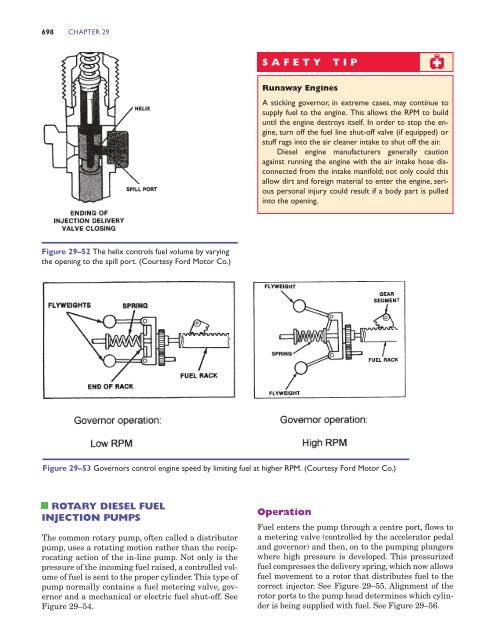Gasoline and Diesel Fuel Injection: Operation ... - Pearson Canada
Gasoline and Diesel Fuel Injection: Operation ... - Pearson Canada
Gasoline and Diesel Fuel Injection: Operation ... - Pearson Canada
Create successful ePaper yourself
Turn your PDF publications into a flip-book with our unique Google optimized e-Paper software.
698 CHAPTER 29<br />
SAFETY<br />
TIP<br />
Runaway Engines<br />
A sticking governor, in extreme cases, may continue to<br />
supply fuel to the engine. This allows the RPM to build<br />
until the engine destroys itself. In order to stop the engine,<br />
turn off the fuel line shut-off valve (if equipped) or<br />
stuff rags into the air cleaner intake to shut off the air.<br />
<strong>Diesel</strong> engine manufacturers generally caution<br />
against running the engine with the air intake hose disconnected<br />
from the intake manifold; not only could this<br />
allow dirt <strong>and</strong> foreign material to enter the engine, serious<br />
personal injury could result if a body part is pulled<br />
into the opening.<br />
Figure 29–52 The helix controls fuel volume by varying<br />
the opening to the spill port. (Courtesy Ford Motor Co.)<br />
Figure 29–53 Governors control engine speed by limiting fuel at higher RPM. (Courtesy Ford Motor Co.)<br />
ROTARY DIESEL FUEL<br />
INJECTION PUMPS<br />
The common rotary pump, often called a distributor<br />
pump, uses a rotating motion rather than the reciprocating<br />
action of the in-line pump. Not only is the<br />
pressure of the incoming fuel raised, a controlled volume<br />
of fuel is sent to the proper cylinder. This type of<br />
pump normally contains a fuel metering valve, governor<br />
<strong>and</strong> a mechanical or electric fuel shut-off. See<br />
Figure 29–54.<br />
<strong>Operation</strong><br />
<strong>Fuel</strong> enters the pump through a centre port, flows to<br />
a metering valve (controlled by the accelerator pedal<br />
<strong>and</strong> governor) <strong>and</strong> then, on to the pumping plungers<br />
where high pressure is developed. This pressurized<br />
fuel compresses the delivery spring, which now allows<br />
fuel movement to a rotor that distributes fuel to the<br />
correct injector. See Figure 29–55. Alignment of the<br />
rotor ports to the pump head determines which cylinder<br />
is being supplied with fuel. See Figure 29–56.

















